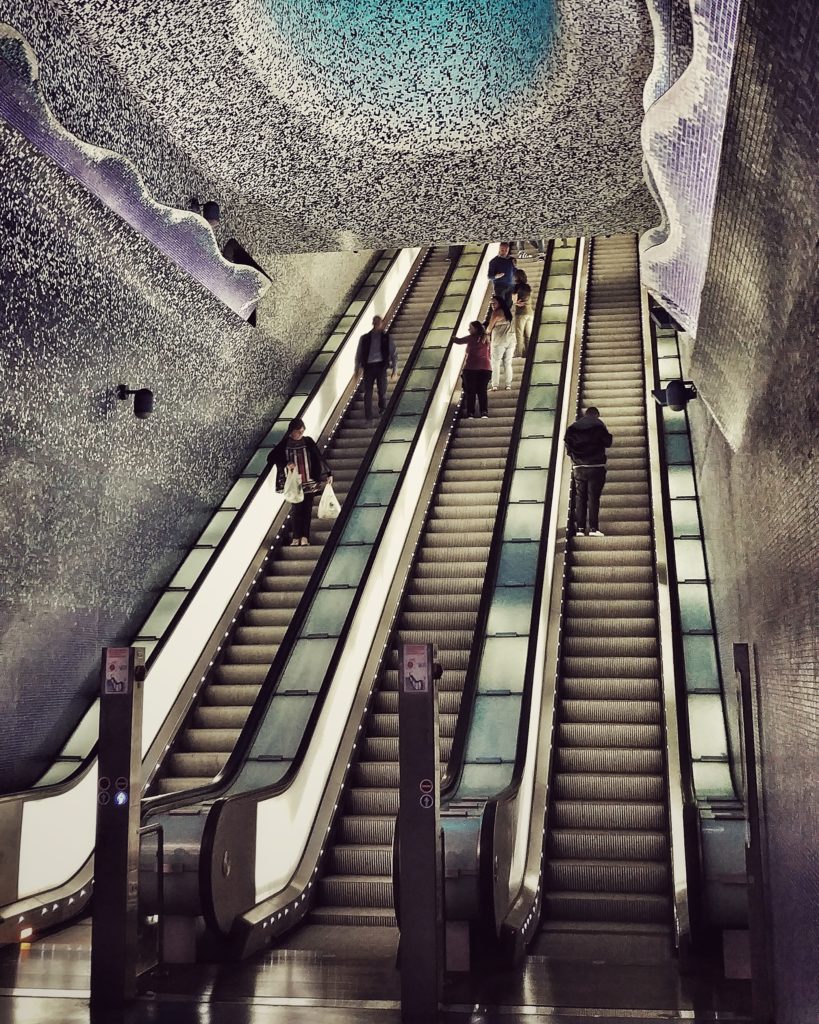
The Naples Metro (Italian: Metropolitana di Napoli; Neapolitan: Metrupulitana ‘e Napule) is the rapid transit system serving the city of Naples, Italy. The system comprises three underground rapid transit lines (Line 1, Line 6 and the Naples-Aversa Metro).
n 1911, construction on the urban section of the Rome–Formia–Naples railway, the Villa Literno–Napoli Gianturco railway was commenced, and although it was suspended for the duration of World War I, the line was eventually opened on 28 September 1925 as an urban railway service line, the first in Italy.[5] This service is now known as Line 2.
After World War II, the existing Circumvesuviana railway was upgraded to a modern commuter rail, and also the Cumana railway became relevant for the commuter transport. In 1962, the Circumflegrea railway was opened.[6]
Construction of the first underground metro railway (Line 1) began in 1976, and the first part opened on 28 March 1993.[7] Initially called the Metropolitana Collinare (“Hills metro”) it ran for 4 km (2.5 mi) between Colli Aminei and Vanvitelli.[4] Two years later, in 1995, the line was extended to reach Piscinola[4] giving an overall track length of 8 kilometres (5.0 mi).[8]
Although progress had been made from the early setbacks and problems, it was still apparent by 1997 that the network suffered badly from the lack of network integration and poor connections, as well as the fact that large areas of Naples were not close to stations. In 1997, the city government drew up a new Piano Comunale dei Trasporti di Napoli (City Transport Plan) which called for a review of the network, improved controls over maintenance expenditure and general finances, a new tariff control system and better management of the urban rail network of Naples.[9]
The transport plan called for a three phase major redevelopment. Phase 1 would involve an expansion to a total of five lines, including major redevelopment of Line 1, and take the network up to 53 km of track (45 km of existing lines), with 68 stations (23 newly built), and 12 interchange nodes, to be completed by 2001. Phase 2 was designed to increase the network to 7 lines, with 84 stations, and 16 interchange nodes, plus 10 bus interchanges, to be completed by 2007. Phase 3 would see the network expanded to 10 rail lines with 93 km of track, and a further 30 km of new light rail (tram lines) linking 114 stations, with 21 interchanges, and 24 bus interchanges to be completed by 2011. The plan called for 70% of Neapolitans to be living within 500 metres of a transport access point by 2011.[8]
In conjunction with the regional government of Campania, the comune government of Naples incorporated a new fully state-controlled joint-stock corporation called Metronapoli, which was 99% controlled by the comune and 1% controlled by ANM (Azienda Napoletana Mobilità), with a mission statement of: “providing an efficient public rail transport service of quality to the city”.
In 2000, a new line, Line 9, was proposed. Intended to connect the National Archaeological Museum via the Museo di Capodimonte, providing an alternative route to part of Line 1, the project was abandoned.
Metronapoli took over responsibility for running the urban rail transport network of Naples as part of a planned massive re-invigoration of public transport in the Campania region, on 1 February 2001. The regional government announced a rivoluzione del ferro (rail revolution) which involved a planned expansion of the region’s network at a cost of €3.8 billion, and would see the construction of 1,400 km of new tracks and 80 new stations for a total of 423 stations on the network within Campania.
On 14 April 2001, service on Line 1 was extended from Vanvitelli to Museum (Museo) station.[4]
In 2005, The Naples-Aversa Metro line opened between Piscinola and Mugnano.
On 3 December 2005, the CIPE (Interdepartmental Committee for Economic Planning) announced over €600 million worth of funding to be spent the Metropolitana di Napoli network. €323 million was allocated for Montesanto station (Cumana and Circumflegrea), €61.1 million for Quattro Giornate station (Line 1 and Circumflegrea), with both projects to be completed by 2010, as well as €119.7 million to be spent to improve the section of Line 1 between Capodichino and Centro Direzionale and €100 million for the San Pasquale–Municipio section.[10]
From 23 December 2006 to 20 February 2007, a special exhibition of models and multimedia presentations was held at Castel dell’Ovo to showcase all of the planned improvements to the Metropolitana di Napoli network, and was extremely well received by Neapolitans.
Line 6, which is categorized as a “light metro” line, opened in February 2007, running on 2.3 kilometres (1.4 mi) of route and serving 4 stations.[11]
In 2009, the Naples-Aversa Metro extended to Aversa Centro.
On 28 March 2011, Line 1 was extended from Museo station to Università.
On 17 September 2012, the Toledo station between Dante and Università opened on Line 1.[4]
On 31 December 2013, Line 1 was extended to Garibaldi right next to the central train station.
On 2 June 2015, the station Municipio (Town Hall) was opened between Università and Toledo on Line 1.
In August 2021, Duomo Station began operating, it’s steel and glass dome delayed by subterranean archeolgical discoveries and related funding and construction pressures.